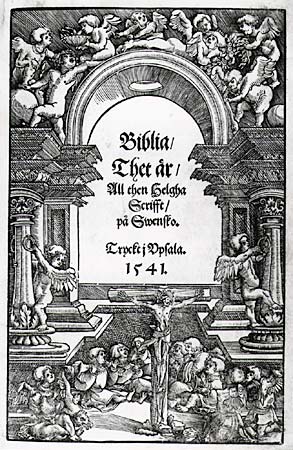Related Research Articles

Eric XIV was King of Sweden from 1560 until he was captured in a rebellion led by his brother John in 1568 and formally deposed 26 January 1569. Eric XIV was the eldest son of Gustav I (1496–1560) and Catherine of Saxe-Lauenburg (1513–1535). He was also ruler of Estonia, after it placed itself under Swedish protection in 1561.

John III was King of Sweden from 1569 until his death. He attained the Swedish throne after a rebellion against his half-brother Eric XIV. He is mainly remembered for his attempts to close the gap between the newly established Lutheran Church of Sweden and the Catholic Church, as well as his conflict with and possible murder of his brother.

Christina Nilsdotter Gyllenstierna of Fogelvik was a Swedish noblewoman. She was married to the Swedish regent Sten Sture the Younger, and led the Swedish resistance against Christian II of Denmark after the death of her spouse. In her own lifetime she was simply referred to as Fru Kristina, but she has become known in history as Kristina Gyllenstierna because of the house of nobility to which she belonged.

Karin Månsdotter was first the mistress and then the Queen of King Eric XIV of Sweden.

Catherine Jagiellon was a princess of the Polish–Lithuanian Commonwealth and Queen of Sweden from 1569 as the wife of King John III. Catherine had significant influence over state affairs during the reign of her spouse. She negotiated with the pope to introduce Counter-Reformation in Sweden. She was the mother of Sigismund III Vasa.

Cecilia of Sweden, was Princess of Sweden as the daughter of King Gustav I and his second wife, Margaret Leijonhufvud, and Margravine of Baden-Rodemachern as the wife of Christopher II, Margrave of Baden-Rodemachern. She is the most famous daughter of Gustav I, known for a courtship scandal in connection with a sister's wedding and for a lengthy stay in England under Elizabeth I where her first child was born.
Jöran Persson, alternatively Göran Persson, was King Eric XIV of Sweden's favorite, most trusted counsellor and head of the King's network of spies. He was widely seen as a Machiavellian figure, and as holding too much influence over Eric. On both occasions on which the King was removed from power, Persson was quickly arrested by the nobility; the second time he was executed shortly after his arrest.
Gustaf Banér was a Swedish noble, member of the Privy Council of Sweden.

Princess Sophia of Sweden, also Sofia Gustavsdotter Vasa, was a Swedish princess, daughter of King Gustav Vasa of Sweden and Margareta Leijonhufvud. She was formally Duchess consort of Saxe-Lauenburg by her marriage to Duke Magnus II of Saxe-Lauenburg.

Princess Elizabeth of Sweden, was a Swedish princess, and a duchess consort of Mecklenburg-Gadebusch by marriage to Christopher, Duke of Mecklenburg-Gadebusch. She was a daughter of King Gustav I of Sweden and his second spouse, Queen Margaret.
Martha Eriksdotter Leijonhufvud, known as Kung Märta, was a politically-active Swedish noblewoman. She was the sister of Queen Margaret Leijonhufvud and sister-in-law of King Gustav I of Sweden: she was also the maternal aunt of Queen Catherine Stenbock and the daughter-in-law of the regent Christina Gyllenstierna. In 1568, she financed the deposition of King Eric XIV of Sweden, which placed her nephew John III of Sweden on the throne.

The Reformation in Sweden is generally regarded as having begun in 1527 during the reign of King Gustav I of Sweden, but the process was slow and was not definitively decided until the Uppsala Synod of 1593, in the wake of an attempted Counter-Reformation during the reign of John III (1568–1592).
Elin Andersdotter, was a Swedish courtier. She served as Chief Court Mistress to queen Karin Månsdotter of Sweden. She is known for being a leading actor in the 1569 Plot to free and reinstate the imprisoned and deposed king Erik XIV of Sweden.

Events from the year 1569 in Sweden
Charles de Mornay, was a Swedish court official, diplomat and royal favorite. He was the central figure of the Mornay plot of 1574.

Hogenskild Bielke was a Swedish baron, court official and riksråd. He was one of the more prominent leaders of the Swedish nobility in their power struggle against royal authority during the 16th-century.
The Mornay plot was a plot in 1574 to assassinate John III of Sweden, free the imprisoned Eric XIV of Sweden and place him or Charles IX of Sweden upon the Swedish throne. The plot was hatched and planned by Charles de Mornay, a Swedish courtier of French Huguenot origin with international contacts. It was one of three major plots to free the imprisoned Eric XIV, preceded by the 1569 Plot and succeeded by the 1576 Plot.
The 1569 Plot was a conspiracy in Sweden in 1569. The purpose was to depose John III of Sweden and reinstate the imprisoned Eric XIV of Sweden on the Swedish throne. The plot was instigated by the courtiers of Eric's spouse queen Karin Månsdotter; her lady-in-waiting Elin Andersdotter and her personal secretary Thomas Jakobsson. It was the first of three major plots to free the imprisoned Eric XIV, but has been described as the most serious one. The plot was exposed and prevented before it could be put in action and resulted in the execution of the conspirators.
Jean Allard or Jehan Alard, was a French adventurer.

Nils Göransson Gyllenstierna, sometimes Nils Jöransson, or Nisse Gyllenstierna was a Swedish statesman and aristocrat who was Lord High Chancellor of Sweden from 1561 to 1590 and Lord high Steward of Sweden from 1590 to 1601. He is most known for assisting Johan III ascend the Swedish throne.
References
- 1 2 3 4 5 6 Wolke, Lars Ericson. "Mauritz Rasmusson". sok.riksarkivet.se. National Archives of Sweden . Retrieved 2024-11-25.